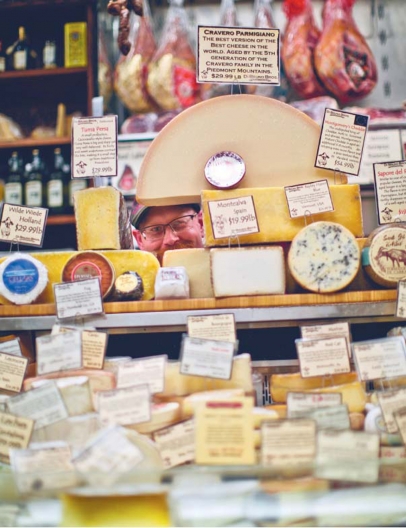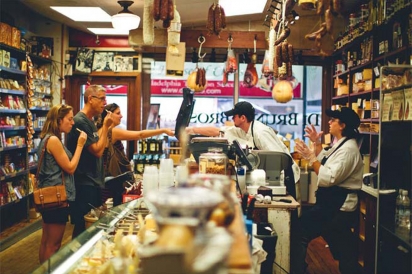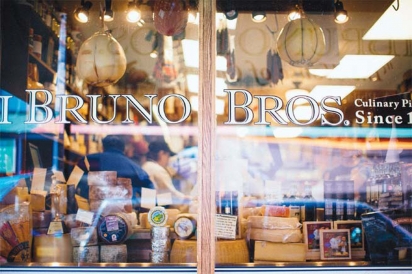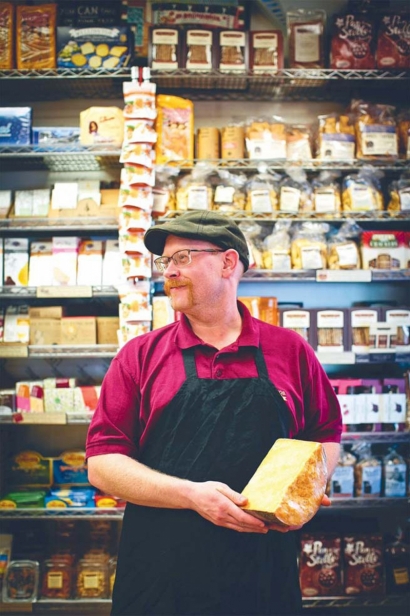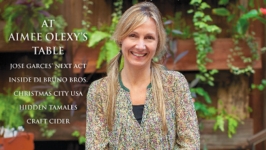Di Bruno Bros: The House that Cheese Built
Ian Peacock has encountered pretty much everything in his six years behind Di Bruno’s venerable Italian Market cheese counter, but there’s one customer course of action that’s never sat well with him. And it never will.
“It baffles me how you can walk in here and not taste anything,” says Peacock, a sincere glimmer of discontent in his voice, after he watches a wandering woman peruse the shelves, curtly dismiss help (and samples) and swiftly book it back out the door onto busy Ninth Street.
Had she lingered, it’s likely Peacock, ever the loquacious salesman, would’ve coaxed her into a bite of Stilton, a nibble of Cabot Clothbound (“slight hint of Cheez-Its,” according to Peacock) or maybe a sliver of one of the Dutch Goudas that hold court on a packed shelf overlooking the meat slicer. She might’ve fallen in love with a cheese she’s never had before. She might’ve made it her new favorite. And, vitally, she might’ve turned from directionless onlooker to regular customer.
When a silver-haired gentleman, strolling with the golf-shirted paunch and tentative gait of a tourist, approaches Peacock and inquires about the popular English Blue Shropshire, the monger misses zero beats. “I don’t have that, but I do have Stilton,” Peacock says, simultaneously talking, smiling and palming a wheel before golf shirt even has a chance to trouble him for a bite. “Of the eight dairies licensed to make Stilton, this is the best.”
He tries it. He nods. He digs it. He asks for a third of a pound, which Peacock hacks off by sight with impressive accuracy (.345 pounds). But before he exits cheese stage right, Peacock gets a couple more items in his bag, including another cheese. Golf shirt probably didn’t know he wanted that second wedge when he entered, but he seems pleased as a piece of Prima Donna to exit with it.
“Most customers have an idea of what they want, so I say let’s turn them on to something new,” Peacock explains later. It’s this precise penchant for inclusive salesmanship that helps turn the merely cheese-curious into Di Bruno’s devotees.
Watching Peacock, a carpenter turned cheesemonger, and the rest of the chef-coated Di Bruno staff work every customer and every angle therein is a tangible reminder of an older way of doing things. In this tiny shop, opened by Abruzzese immigrants Danny and Joe Di Bruno in 1939 and owned and run by their grandsons, cousins Emilio and Bill Mignucci, since 1990, they stock upward of 350 cheeses including Italiano staples like Parmesan and Locatelli, sure, but also picks so exotic and versatile they merited a whole cookbook, Di Bruno Bros. House of Cheese, that came out from Running Press this past spring.
Physically and fiscally, narrow Ninth Street is a blip compared to the volume that Di Bruno’s does at its other locations, in Rittenhouse, inside the Comcast Center, in the Ardmore Farmers’ Market and at its new space in Center City East. The business employs close to 300 people and run a busy e-commerce business from the website. But the Italian Market, the neighborhood where the Mignuccis were both born, holds a cachet that can’t just be replicated by throwing money at blank-canvas real estate.
Yes, the original shop, in its current iteration, sells luxe charcuterie, Fee Brothers bitters, high-end sweets and all sorts of other specialty grocery items that’d likely give its blue-collar founders pause. But diversifying the product line, a task taken on by energetic “director of culinary pioneering” Emilio, was essential for the growth of the company. “People would come in and ask for stuff we didn’t have that was so very typically European. So I thought, we should have that stuff,” he says.
For the sake of history, family and the business buoyancy of this slice of South Philly, it’s important that Ninth Street not just survive, but thrive. Di Bruno’s location here may be the smallest jewel in the family’s crown, but tradition helps it shine the brightest.
“For a young person like me, totally, awkwardly obsessed with food, going in there was like coming home,” says Gilda Doganiero, who frequented Di Bruno’s as a kid alongside her Italian family. “Here I was, surrounded on all four sides by so many incredible ingredients. It was like a library of taste—a total education.” Still a loyal customer, the accomplished baker also counts herself among the company’s vendors—her Gilda’s Biscotti brand is carried at all Di Bruno’s shops. Ninth Street employees approach their jobs with a jovial brand of queso consiglieri intensity that likely makes less-dedicated food purveyors heave inferior sighs. “All our other stores are set up as a passive shopping experience,” says Peacock. “This is more of a boutique.” And a boutique needs to be staffed by people who know what the hell they’re talking about. Di Bruno’s mongers, whether they have well-seasoned food résumés or not, become cheese experts via two time-honored professional methods: repetition and initiation.
“You learn more than you thought you would in such a short amount of time,” says Samantha Kane, a former line cook new to the Di Bruno’s fold. “I’d probably have the same learning curve coming from a non-food background.” While Ann Campbell, another former line cook, rhapsodized about the musty and sweet notes of a Sardinian Pecorino to a wide-eyed mom type, Kane waits on a much more challenging guest: experienced monger Joe Green, playing the role of the most difficult cheese customer in the history of retail. The exercise, designed to get Kane and fellow recent hire David Harper thinking on their feet, involves Green acting as a miserly, cheese knowledge-light but attitude-heavy walk-in looking for options to impress the parents of his significant other.
When Kane responds to Green’s concerns of price by bringing up smaller portions or more affordable options, he steps out of character with a case-relevant comeback she could’ve tossed out there. “What does cost matter? I thought you were trying to impress them,” says Green. “Your confidence is going to sell this cheese,” he tells his young charge.
“You make me nervous,” replies Kane, who admits that committing hundreds of snappy cheese descriptions to memory is an uphill climb.
Observing from the other end of the counter, Peacock approves of the tough-love approach. “Joe’s giving them a good hard time,” he says. “That’s because we usually get a good hard time from our customers.” Those customers, which Peacock estimates is one-third regulars, one-third chefs and one-third tourists, are never more present than during the Philadelphia holiday season, when the shop, its floor plan no bigger than a one-car garage, begins resembling a packed butt-to-gut concert venue. “The line starts a week and a half before Thanksgiving and doesn’t stop until New Year’s Eve,” says Peacock. “Christmas Eve is notorious. It’s like waiting in line for the next iPhone,” says Doganiero. “People start lining up before the sun even rises.” When she and her husband lived a few blocks from the shop, they would roast a whole pork shoulder and drop it off to the mongers before the December 24 opening bell to make sure they had something to eat during the madness.
Longtime customer Felicia D’Ambrosio, meanwhile, earmarks December 23 for her annual surgical strike on the Di Bruno’s queue, with the aim of bringing Ninth Street’s flavors to out-of-town family. “Our mom-mom is from South Philly but moved away to Lancaster, and she misses the Italian-American meats and cheeses you can’t really get in central Pennsylvania,” says D’Ambrosio, who typically fills her bag with Parmesan, funky blues, olives, octopus salad and fancy jamón Ibérico that she and her sister deliver to their grandmother and great-aunt If noobs like Kane and Harper are going to survive this holiday, Peacock says, they’re going to have to develop an arsenal of funny retorts and cranky guest-assuaging skills to go along with their sales tactics and food factoids.
Thankfully, a relatively slow afternoon in September allows for both monger-on-monger training and shoot-the-breeze sessions with regulars, an Italian Market must. Peter Woolsey, chef of the nearby Bistrot La Minette, pops in the door, catching up with Peacock before snagging a small hunk of Ossau-Iraty, a Basque sheep’s milk cheese he uses in a tartine on his brunch menu.
“There’s an immediate selection—I can see the cheese before I buy it,” says Woolsey of what appeals to him about the shop. “Plus, I can get small amounts of things. Gourmet food purveyors often require a minimum order.”
As Campbell cracks up a customer with her fabricated endorsement of jarred Rare Bird Preserves (“I actually trained the rare birds that flew that here—I have mad aviculture skills”), Peacock tries in vain to push a woman who only wants a package of pizzelles toward a more ambitious purchase.
“Need cheese to go on these pizzelles? Maybe mascarpone, make a little sandwich?” he inquires. When she resists, Peacock takes one last swing. “Well then, from everyone at Di Bruno Brothers’ House of Pizzelles, we thank you.”
Green walks a blue cheese fan toward a variety of Roquefort he’s particularly fond of. “There’s this old man who makes every wheel himself,” he says. “I hope to God he’s teaching his daughter how to do it,” says Peacock.
Engaging customers in unorthodox ways, structured or otherwise, has always been a hallmark of the Di Bruno identity, especially at this location. It’s a style Bill Mignucci defines as “servant leadership” in House of Cheese. “Servant leaders prioritize the needs of their colleagues and those they serve,” he writes. “Very humbly, they lead by serving.”
Exemplifying this ideal is Rico Molanco, a Mexican native who’s been working the line for Di Bruno’s for 14 years, making him one of the company’s longest-tenured employees. Between knocking out customer orders with a smile, he rummages through a lower drawer to show off some dog-eared old snapshots of him as a fresh-faced teenager, working in the shop with the old-timers. He bounces around the locations, an indispensable five-tool utility man. “Wherever they send me, I go,” he says.
Years on the grind are required to reach Molanco’s level, but everyone’s got to begin somewhere—and in the case of more recent hires, that starting point involves an unavoidable hazing ritual or two. While customer role-playing hones extemporaneous skills, there are in-house rites of passage that challenge and mold a monger’s inner cheese-hawking psyche.
One key ritual for new employees is what’s referred to as the “Antipasti Olympics.” New cheesemongers are tasked with eating one of every single item on the Di Bruno antipasti bar—dozens of olive varieties, roasted peppers, stuffed artichokes, marinated mushrooms, you name it. You’ve got to complete the course in 15 minutes or less, lest you endure the ribbing of your coworkers. (I attempted, and successfully completed, the Olympics, but not in the time allotted. It’s harder than it sounds. My insides are now permanently pickled from all the brine.)
“It’s an evil thing to do,” says Peacock, smiling in such a way that suggests it probably doesn’t make him feel too bad. “But it’s fun with a purpose.”
Mignucci is comfortable distilling his own understanding of Di Bruno’s greater purpose into a single line: “We want to celebrate great food, great people and great business,” he says. The brand has evolved dramatically since the days of Danny and Joe, but the founding philosophy doesn’t change.
“We didn’t even take it into consideration that Di Bruno’s would not be there. Our grandparents worked their butts off to create something. We don’t want it to go anywhere.” From the looks of the line snaking out the shop’s door down the cramped sidewalk on Ninth Street, food lovers will indeed keep Di Bruno’s in business forever.


